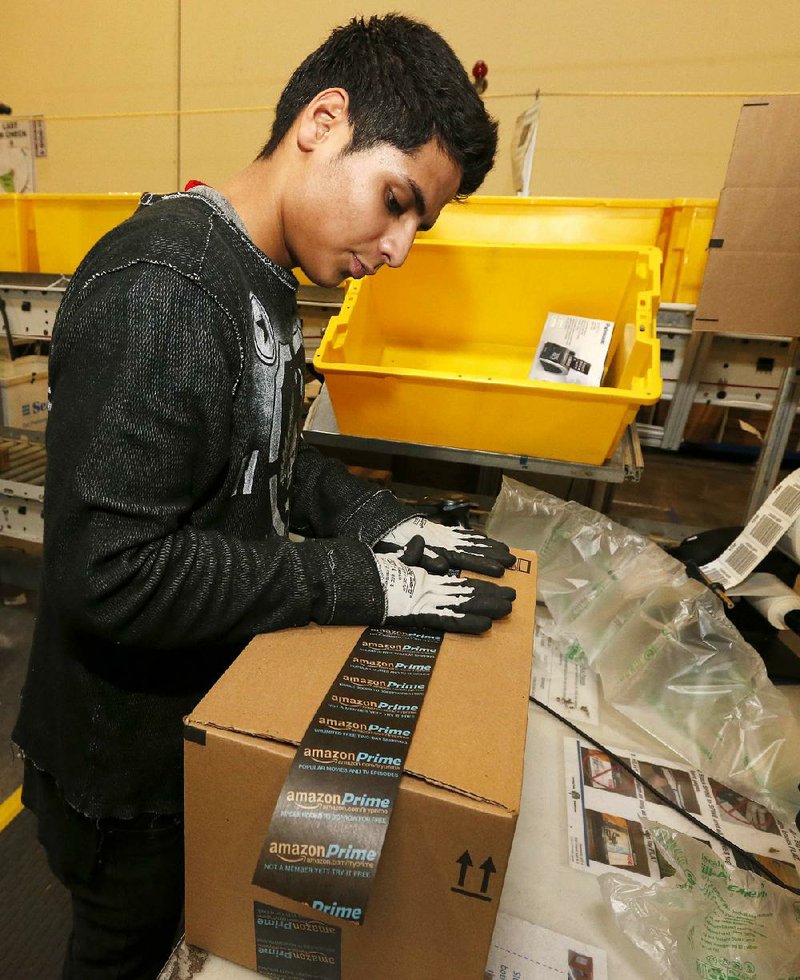Online sales surge d Monday, sending Internet shopping toward a single day record as Amazon.com Inc. and eBay Inc. siphoned consumers from brick-and mortar stores.
INTERACTIVE
Online sales rose 21 percent from 2012, International Business Machines Corp. said in a statement. Retailers catering to smartphone and tablet users benefited the most, with mobile traffic accounting for 32 percent of site visits, a 45 percent gain from last year.
Research firm comScore Inc., which tracks online sales, said Tuesday that ecommerce spending rose 18 percent from last year’s Cyber Monday to $1.74 billion, making Monday the top online spending day since comScore began tracking the data in 2001. The figure does not include purchases from mobile devices.
E-commerce is projected to be the bright spot of an otherwise tepid Christmas shopping season marked by the first Black Friday-weekend spending decline since 2009. Although Internet sales may climb as much as 15 percent, more than three times faster than overall retail growth, they still account for just 14 percent of the total, according to the National Retail Federation.
“The results thus far from an e-commerce perspective have been very strong - certainly strong relative to brick-and-mortar stores,” said Ron Josey, an analyst at JMP Securities Inc. in New York. “This is the first holiday season where mobile is absolutely having its mark on overall retail sales, whether that’s from a smartphone or a tablet. It’s not going away.”
Online spending in-creased 15 percent to a record $1.2 billion on Black Friday, according to research by ComScore Inc. Still, because of the in-store slump, total purchases fell 2.9 percent to $57.4 billion during the four days beginning with the Thanksgiving holiday, according to a survey commissioned by the National Retail Federation.
The results reinforced declining investor optimism about U.S. Christmas sales, as signaled by the performance of two small-cap stock groups. The Russell 2000 consumer discretionary index has trailed the Russell 2000 consumer staples index by 1.7 percentage points since Nov. 25, reversing almost one-third of its relative gains during the previous two months.
The performance of the indexes in the past week shows investors are less sanguine about the Christmas season, said Tim Ghriskey, chief investment officer at Solaris Group LLC in Bedford Hills, N.Y., which manages over $1.5 billion.
Internet sales may climb to $82 billion in the Christmas season, more than three times faster than total retail growth of 3.9 percent to $602.1 billion, according to the National Retail Federation.
In terms of sales, mobile devices drove more than 17 percent of online purchases Monday, International Business Machines Corp. said.
Online retailers are catering to consumers such as Camille Schmidt, 25, who owns a marketing company and primarily shops on the Web. Schmidt scanned her email for big discount headlines Monday morning and allotted time to shop after work in the evening.
“I’m looking for the highest percentage discount,” she said, noting that a coupon for40 percent off at Juicy Couture landed in her inbox. “I usually know what I want, and they’re usually designer brands. I’m just waiting to see how far they’ll go.”
Amazon’s same-store sales rose 47 percent from last year as of 10:30 a.m. New York time Monday, while eBay’s increased 21 percent, according to ChannelAdvisor Inc., which provides services to sellers on both of those sites.
Shopping on tablets and smartphones increased twice as fast in the third quarter as desktop online spending, according to ComScore. Web users in August spent more time engaging with retailers on mobile devices than on desktops for the first time, the firm said. EBay’s PayPal unit said in a statement that mobile payment volume more than doubled as of 2 p.m. New York time Monday compared with a year earlier.
Information for this article was contributed by Mary Schlangenstein and Gerrit De Vynck of Bloomberg News and by Mae Anderson and Sarah Skidmore Sell of The Associated Press.
Business, Pages 25 on 12/04/2013

